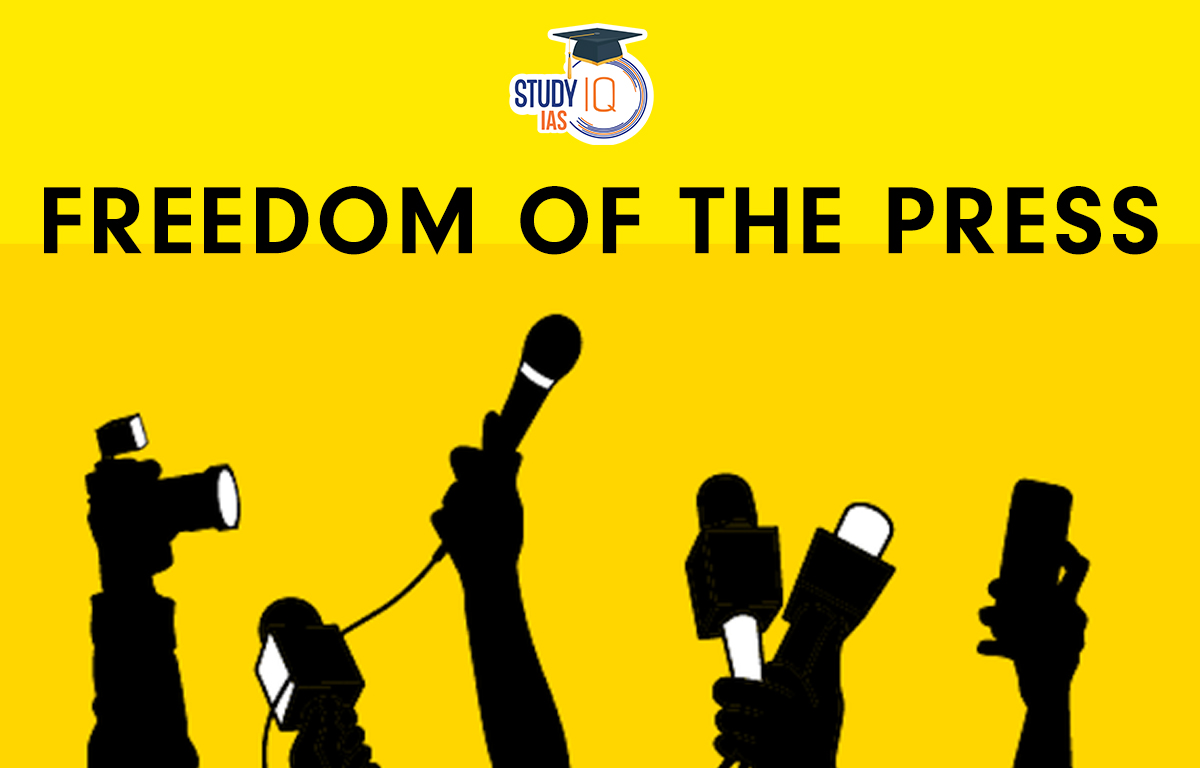Table of Contents
Context: The Supreme Court has recently ruled that the decision of the government to not renew the broadcast licence of Malayalam channel MediaOne was a violation of freedom of the press.
More on the Freedom of the Press News
- The Court further stated that criticism of government policy cannot be considered a “reasonable restriction” under Article 19(2) of the Constitution, which guarantees the freedom of speech and expression.
- In other words, the Court held that the government cannot use its power to restrict the freedom of the press in a manner that prevents criticism of its policies or actions.
- The ruling emphasizes the importance of press freedom as a fundamental right, and highlights the need for governments to protect and uphold this right in order to ensure a free and democratic society.
What is Freedom of Press?
- Freedom of the press is a fundamental right that guarantees the ability of individuals and organizations, including journalists and media outlets, to publish and disseminate information without fear of censorship or retaliation.
- It is an absence of statutory and administrative control on dissemination of ideas, knowledge and thoughts.
- In practical terms, freedom of the press means that individuals have the right to express their opinions and ideas through various forms of media, such as print, broadcast, and online platforms, and to report on events and issues of public interest.
- This right also includes the freedom to access information and to hold those in power accountable for their actions.
Constitutional Recognition
- Freedom of the press is enshrined in the constitutions of many countries and is recognized as a fundamental human right by international organizations such as the United Nations.
- In India, the freedom of the press is not explicitly mentioned in the Indian Constitution, but it is considered a part of the broader freedom of speech and expression guaranteed under Article 19(1)(a) of the Constitution.
- The media, like any citizen, has the right to free speech and expression and the right to publish and circulate information.
- This includes the right to conduct interviews, report on court proceedings, advertise, and receive information.
- However, these rights are subject to certain restrictions under Article 19(2) of the Constitution. These restrictions can be imposed in the interest of:
- Sovereignty and integrity of India
- Security of the State
- Friendly relations with foreign states
- Public order, decency, or morality
- Contempt of court
- Defamation, and
- Incitement to an offence
- The restrictions are necessary to ensure that the freedom of the press is not misused to create a threat to the nation’s security.
- While exercising their freedom, the media must also abide by ethical standards and principles, such as avoiding defamation, sensationalism, or incitement to violence.
Why is the Media called the Fourth Pillar of Democracy?
In India, the media is considered the fourth pillar of democracy after the executive, legislative, and judiciary branches of the government.
- Holding power accountable: The media acts as a watchdog, keeping an eye on the actions of the government, politicians, and other powerful entities. It investigates and reports on issues that are of public interest, exposes corruption and malpractices, and holds those in power accountable for their actions.
- Informing the public: The media provides information to the public on issues related to politics, governance, and other aspects of public life. This information is crucial for citizens to make informed decisions, participate in the democratic process, and hold those in power accountable.
- Advocating for public interest: The media plays a key role in advocating for the public interest. It raises awareness about important issues and voices the concerns and grievances of the public. This helps in shaping public opinion, which in turn can influence policy decisions.
- Providing a platform for dissent: The media provides a platform for people to express dissenting views, opinions, and ideas. This is crucial in a democracy where freedom of expression is a fundamental right. The media acts as a facilitator of free speech, allowing diverse voices to be heard.
- Strengthening a nation: Free media works towards strengthening the sovereignty and integrity of a nation.
- Fundamental to a democratic society: The freedom of press is fundamental to a democratic society like India for it is helpful in strengthening democracy.
- Awareness & Good Governance: Media make society aware of their democratic rights and fight the three institutions of democracy. Media plays an important role in audit of government policies and spending. An unbiased media is important for transparent reporting.
Current Status of Press in India
Freedom of Press in India is generally considered to be free and vibrant. However, in recent years, there have been concerns about the erosion of press freedom in India. Some of the key issues include:
- Intimidation and harassment of journalists: Journalists in India have been subjected to intimidation, harassment, and physical attacks by both state and non-state actors. This has created a climate of fear, which can lead to self-censorship.
- As of 2021, 6 journalists have been killed because of their work.
- India is among the top 4 countries with the most number of deaths on record.
- Legal challenges: There have been several cases where journalists and media organizations have been sued for defamation or sedition, which can have a chilling effect on free speech.
- Government control: The government has a significant influence over the media in India, particularly through its control of broadcast frequencies and advertising revenue. This can lead to self-censorship by media organizations that are dependent on government funding or support.
- Internet shutdowns: The government has been increasingly using internet shutdowns as a means of suppressing dissent and controlling the flow of information. This can severely restrict the ability of journalists and media organizations to report on events and issues.
- Lack of media literacy: Many people in India, particularly in rural areas, may not be aware of the concept of fake news and may not have the skills to identify it. This makes them vulnerable to being misled by false information.
- Misuse of social media: Social media platforms like Facebook, Twitter, and WhatsApp have become popular tools for spreading fake news and propaganda that can be harmful to society.
- Pressure from political parties and business interests: Media houses in India often face pressure from political parties and business interests to promote certain agendas or suppress certain stories. This can result in biased reporting and the spread of false information.
- Lack of regulation: India has a large number of media outlets, both traditional and digital, and there is often a lack of regulation and oversight. This can lead to the spread of false information and unethical practices like paid news.

World Press Freedom Index 2022: India’s Performance
- India has fallen eight places from 142nd to 150th in the 2022 among the 180 countries.
- India’s position has been consistently falling in the index since 2016 when it was ranked 133.
Reasons behind the Fall in Ranking of India
- Pressure from Government: According to the index the media in India, among nations reputed to be more democratic, faces pressure from “increasingly authoritarian and/or nationalist governments”.
- Faults in Policy Framework: Although the policy framework is protective in theory, it resorts to using defamation, sedition, contempt of court, and endangering national security against journalists critical of the government, branding them as “anti-national.”
- India is World’s Most Dangerous Countries for Media persons: According to the report, India is also one of the world’s most dangerous countries for media persons.
- On Kashmir Issue: The situation in Kashmir remains “worrisome” and reporters are often harassed by police and paramilitaries.
Landmark Supreme Court judgments related to freedom of press in India
- Romesh Thapar v. State of Madras (1950): This case established that freedom of speech and expression, which includes the freedom of the press, is a fundamental right protected by the Constitution of India.
- Sakal Papers Ltd. v. Union of India (1962): This case established that government restrictions on the size and number of advertisements that newspapers could publish were a violation of freedom of speech and expression.
- Bennett Coleman & Co. v. Union of India (1973): This case established that the government’s power to restrict the freedom of the press in the interests of public order or morality must be exercised within narrow and clearly defined limits.
- Indian Express Newspapers v. Union of India (1985): This case established that the freedom of the press includes the freedom to criticize the government and that government officials must be held to a higher standard of tolerance for criticism than private citizens.
- Secretary, Ministry of Information and Broadcasting v. Cricket Association of Bengal (1995): This case established that the right to receive information was a fundamental right protected by the Constitution and that the government had a duty to ensure that citizens had access to accurate and objective information.
- Sahara India Real Estate Corporation Ltd. v. SEBI (2012): This case established that the media has a duty to act responsibly and in the public interest, and that media freedom does not extend to defaming individuals or institutions without justification.


 AI Maker Labs: A Promise to build AI in ...
AI Maker Labs: A Promise to build AI in ...
 Daily Quiz 15 April 2025
Daily Quiz 15 April 2025
 How RBI Responded To Global Trade War Ch...
How RBI Responded To Global Trade War Ch...





















